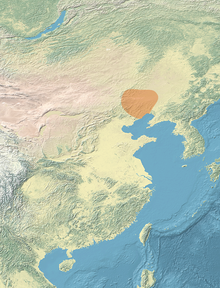
Back Cultura del Xiajiadian superior Catalan Xiajiadian German Cultura del Xiajiadian superior Spanish Culture de Xiajiadian supérieur French 夏家店上層文化 Japanese 샤자뎬 상층문화 Korean Late Xiajiadiancultuur Dutch Den øvre xiajiadiankulturen NB Культура верхнего слоя Сяцзядянь Russian 夏家店上層文化 Chinese
General location of the Upper Xiajiadian culture, and contemporary Asian polities c. 1000 BCE | |
| Dates | 1000-600 BCE |
|---|---|
| Preceded by | Lower Xiajiadian culture |
| Followed by | Jinggouzi culture Donghu people (600-150 BCE)[1] |



The Upper Xiajiadian culture (simplified Chinese: 夏家店上层文化; traditional Chinese: 夏家店上層文化; pinyin: Xià jiā diàn shàngcéng wénhuà) (c. 1000-600 BC[5]) was a Bronze Age archaeological culture in Northeast China derived from the Eurasian steppe bronze tradition.[6] It is associated with the Donghu ("Eastern Barbarians") of Chinese history.
- ^ a b Drennan, Robert D. (2014). "Settlement and Social Dynamics in the Upper Daling and Chifeng Regions of Northeastern China". Asian Archaeology. 2: 50–76.
- ^ Psarras, Sophia-Karin (January 1999). "Upper Xiajiadian". Monumenta Serica. 47 (1): 90, Figure 19. doi:10.1080/02549948.1999.11731324.
- ^ "Certificate".
- ^ Rawson, Jessica (2020). "Chariotry and Prone Burials: Reassessing Late Shang China's Relationship with Its Northern Neighbours". Journal of World Prehistory. 33 (2): 138–168. doi:10.1007/s10963-020-09142-4. S2CID 254751158.
- ^ Shelach, pp. 143
- ^ Barnes, pp. 153
© MMXXIII Rich X Search. We shall prevail. All rights reserved. Rich X Search
